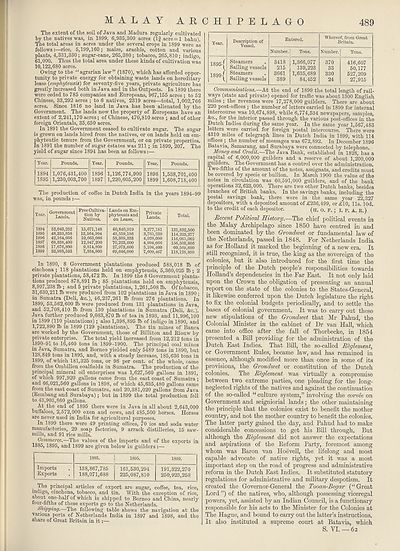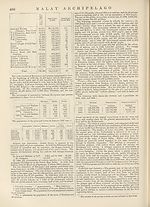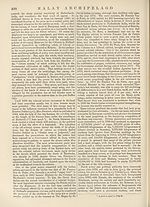New volumes of the Encyclopædia Britannica > Volume 30, K-MOR
(519) Page 489
Download files
Complete book:
Individual page:
Thumbnail gallery: Grid view | List view

MALAY ARCHIPELAGO
489
The extent of the soil of Java and Madura regularly cultivated
by the natives was, in 1899, 6,935,300 acres (If acre = l bahu).
The total areas in acres under the several crops in 1899 were as
follows:—rice, 5,199,160 ; maize, arachis, cotton and various
plants, 4,331,330; sugar-cane, 265,380; tobacco, 265,810; indigo,
61,000. Thus the total area under these kinds of cultivation was
10,122,680 acres.
Owing to the “agrarian law” (1870), which has afforded oppor¬
tunity to private energy for obtaining waste lands on hereditary
lease (emphyteusis) for seventy-five years, private agriculture has
greatly increased both in Java and in the Outposts. In 1899 there
were ceded to 785 companies and Europeans, 967,155 acres ; to 52
Chinese, 33,292 acres ; to 6 natives, 2319 acres—total, 1,002,766
acres. Since 1816 no land in Java has been alienated by the
Government. The lands now the property of Europeans have an
extent of 2,241,170 acres; of Chinese, 470,810 acres ; and of other
foreign Orientals, 35,650 acres.
In 1891 the Government ceased to cultivate sugar. The sugar
is grown on lands hired from the natives, or on lands held on em¬
phyteutic tenure from the Government, or on private properties.
In 1891 the number of sugar estates was 211; in 1899, 207. The
yield of sugar since 1894 has been as follows:—
Pounds.
1894 11,076,431,400
1895 [1,230,003,700
Year.
1896
1897
Pounds.
1,126,774,900
1,220,605,200
Year.
1898
1899
Pounds.
1.538.701.400
1.608.718.400
The production of coffee in Dutch India in the years 1894-99
was, in pounds :—
Year.
Government F^eCultiva- Lands on Em.
1894
1895
1896
1897
1898
1899
Lands.
52,043,252
48,333,858
42,164,666
68,338,400
17,676,800
32,988,533
tion by
Natives.
15,671,148
13,564,994
10,663,066
12,947,200
9.814.800
7.884.800
phyteusis and
on Lease.
60,840,919
48,559,186
58,309,333
70.223.600
27.973.600
69,646,000
Private
Lands.
3,277,181
3,765,239
4,928,000
4,994,666
5,104,400
7,609,467
Total.
131,832,500
114,223,277
116,065,065
156,503,866
60,569,600
118,128,800
In 1890, 8 Government plantations produced 588,018 lb of
cinchona ; 118 plantations held on emphyteusis, 5,360,025 lb; 2
private plantations, 58,472 lb. In 1899 the 8 Government planta¬
tions produced 878,891 lb ; 85 plantations held on emphyteusis,
8,997,238 lb ; and 5 private plantations, 1,261,508 lb. Oftobacco,
31,630,211 lb were produced from 102 plantations in Java in 1890 ;
in Sumatra (Deli, &c.), 46,237,261 lb from 276 plantations. In
1899, 53,562,600 lb were produced from 131 plantations in Java,
and 52,708,410 lb from 130 plantations in Sumatra (Deli, &c.).
Java further produced 9,083,870 lb of tea in 1893, and 11,996,100
in 1899 (110 plantations); also 1,398,895 lb of indigo in 1890, and
1,722,890 lb in 1899 (129 plantations). The tin mines of Banca
are worked by the Government, those of Billiton and Riouw by
private enterprise. The total yield increased from 12,212 tons in
1890-91 to 16,460 tons in 1899-1900. The principal coal mines
in Java, Sumatra, and Borneo yielded only 5489 tons in 1890, but
128,849 tons in 1895, and, with a steady increase, 185,636 tons in
1899, of which 181,325 tons, or 98 per cent, of the whole, came
from the Ombilien coalfields in Sumatra. The production of the
principal mineral oil enterprises was 1,627,560 gallons in 1891,
of which 997,920 gallons came from the east coast of Sumatra ;
and 66,021,560 gallons in 1898, of which 45,635,480 gallons came
from the east coast of Sumatra, and 20,381,020 gallons from Java
(Rembang and Surabaya); but in 1899 the total production fell
to 43,903,860 gallons.
At the end of 1895 there were in Java in all about 2,643,000
buffaloes, 2,572,000 oxen and cows, and 485,500 horses. Horses
are never used in India for agricultural purposes.
In 1899 there were 49 printing offices, 70 ice and soda water
manufactories, 29 soap factories, 9 arrack distilleries, 15 saw¬
mills, and 91 rice mills.
Commerce.—The values of the imports and of the exports in
1885, 1895, and 1899 are given below in guilders :—
Imports
Exports
1885.
1895.
138,867,785
188,071,688
161,530,294
225,087,810
191,322,270
250,923,258
• P('incipal articles of export are sugar, coffee, tea, rice,
indigo, cinchona, tobacco, and tin. With the exception of rice,
about one-half of which is shipped to Borneo and China, nearly
four-fifths of these exports go to the Netherlands.
Shipping.—The following table shows the navigation at the
various ports of Netherlands India in 1897 and 1898, and the
share of Great Britain in it:—
Year.
1895j
1899/
Description of
Vessel.
Steamers
Sailing vessels
Steamers
Sailing vessels
Entered.
Number. I
Tons.
3418
215
3661
389
1,366,077
139,223
1,635,689
84,452
Whereof, from Great
Britain.
Number. I
Tons.
370
33
330
24
416,607
50,177
527,209
27,915
Communications.—Kt the end of 1899 the total length of rail¬
ways (state and private) opened for traffic was about 1300 English
miles ; the revenues were 17,278,000 guilders. There are about
220 post-offices ; the number of letters carried in 1899 for internal
intercourse was 10,674,898, while 6,774,534 newspapers, samples,
&c., for the interior passed through the various post-offices in the
Dutch Indies during the same year. In the same year 1,567,483
letters were carried for foreign postal intercourse. There were
4310 miles of telegraph lines in Dutch India in 1899, with 114
offices ; the number of messages was 672,892. In December 1896
Batavia, Samarang, and Surabaya were connected by telephone.
Money and Credit.—The Java Bank, established in 1828, has a
capital of 6,000,000 guilders and a reserve of about 1,200,000
guilders. The Government has a control over the administration.
Two-fifths of the amount of the notes, assignats, and credits must
be covered by specie or bullion. In March 1900 the value of the
notes in circulation was 60,591,000 guilders, and of the bank
operations 32,623,000. There are two other Dutch banks, besides
branches of British banks. In the savings banks, including the
postal savings bank, there were in the same year 22,327
depositors, with a deposited amount of £236,499, or £10, 11s. lOd.
to the credit of each depositor. (h. O. F.; I. P. A. R )
Recent Political History.—The chief political events in
the Malay Archipelago since 1850 have centred in and
been dominated by the Grondwet or fundamental law of
the Netherlands, passed in 1848. For Netherlands India
as for Holland it marked the beginning of a new era. It
still recognized, it is true, the king as the sovereign of the
colonies, but it also introduced for the first time the
principle of the Dutch people’s responsibilities towards
Holland’s dependencies in the Far East. It not only laid
upon the Crown the obligation of presenting an annual
report on the state of the colonies to the States-General,
it likewise conferred upon the Dutch legislature the right
to fix the colonial budgets periodically, and to settle the
bases of colonial government. It was to carry out these
new stipulations of the Grondwet that Mr Pahud, the
Colonial Minister in the cabinet of Dr van Hall, which
came into office after the fall of Thorbecke, in 1854
presented a Bill providing for the administration of the
Dutch East Indies. That Bill, the so-called Reglement,
or Government Rules, became law, and has remained in
essence, although modified more than once in some of its
provisions, the Grondwet or constitution of the Dutch
colonies. The Reglement was virtually a compromise
between two extreme parties, one pleading for the long-
neglected rights of the natives and against the continuation
of the so-called “ culture system,” involving the corvee on
Government and seigniorial lands; the other maintaining
the principle that the colonies exist to benefit the mother
country, and not the mother country to benefit the colonies.
The latter party gained the day, and Pahud had to make
considerable concessions to get his Bill through. But
although the Reglement did not answer the expectations
and aspirations of the Reform Party, foremost among
whom was Baron van Hoevell, the lifelong and most
capable advocate of native rights, yet it was a most
important step on the road of progress and administrative
reform in the Dutch East Indies. It substituted statutory
regulations for administrative and military despotism. It
created the Governor-General the Tooan-Begar (“Great
Lord ”) of the natives, who, although possessing viceregal
powers, yet, assisted by an Indian Council, is a functionary
responsible for his acts to the Minister for the Colonies at
The Hague, and bound to carry out the latter’s instructions.
It also instituted a supreme court at Batavia, which
S. VI. — 62
489
The extent of the soil of Java and Madura regularly cultivated
by the natives was, in 1899, 6,935,300 acres (If acre = l bahu).
The total areas in acres under the several crops in 1899 were as
follows:—rice, 5,199,160 ; maize, arachis, cotton and various
plants, 4,331,330; sugar-cane, 265,380; tobacco, 265,810; indigo,
61,000. Thus the total area under these kinds of cultivation was
10,122,680 acres.
Owing to the “agrarian law” (1870), which has afforded oppor¬
tunity to private energy for obtaining waste lands on hereditary
lease (emphyteusis) for seventy-five years, private agriculture has
greatly increased both in Java and in the Outposts. In 1899 there
were ceded to 785 companies and Europeans, 967,155 acres ; to 52
Chinese, 33,292 acres ; to 6 natives, 2319 acres—total, 1,002,766
acres. Since 1816 no land in Java has been alienated by the
Government. The lands now the property of Europeans have an
extent of 2,241,170 acres; of Chinese, 470,810 acres ; and of other
foreign Orientals, 35,650 acres.
In 1891 the Government ceased to cultivate sugar. The sugar
is grown on lands hired from the natives, or on lands held on em¬
phyteutic tenure from the Government, or on private properties.
In 1891 the number of sugar estates was 211; in 1899, 207. The
yield of sugar since 1894 has been as follows:—
Pounds.
1894 11,076,431,400
1895 [1,230,003,700
Year.
1896
1897
Pounds.
1,126,774,900
1,220,605,200
Year.
1898
1899
Pounds.
1.538.701.400
1.608.718.400
The production of coffee in Dutch India in the years 1894-99
was, in pounds :—
Year.
Government F^eCultiva- Lands on Em.
1894
1895
1896
1897
1898
1899
Lands.
52,043,252
48,333,858
42,164,666
68,338,400
17,676,800
32,988,533
tion by
Natives.
15,671,148
13,564,994
10,663,066
12,947,200
9.814.800
7.884.800
phyteusis and
on Lease.
60,840,919
48,559,186
58,309,333
70.223.600
27.973.600
69,646,000
Private
Lands.
3,277,181
3,765,239
4,928,000
4,994,666
5,104,400
7,609,467
Total.
131,832,500
114,223,277
116,065,065
156,503,866
60,569,600
118,128,800
In 1890, 8 Government plantations produced 588,018 lb of
cinchona ; 118 plantations held on emphyteusis, 5,360,025 lb; 2
private plantations, 58,472 lb. In 1899 the 8 Government planta¬
tions produced 878,891 lb ; 85 plantations held on emphyteusis,
8,997,238 lb ; and 5 private plantations, 1,261,508 lb. Oftobacco,
31,630,211 lb were produced from 102 plantations in Java in 1890 ;
in Sumatra (Deli, &c.), 46,237,261 lb from 276 plantations. In
1899, 53,562,600 lb were produced from 131 plantations in Java,
and 52,708,410 lb from 130 plantations in Sumatra (Deli, &c.).
Java further produced 9,083,870 lb of tea in 1893, and 11,996,100
in 1899 (110 plantations); also 1,398,895 lb of indigo in 1890, and
1,722,890 lb in 1899 (129 plantations). The tin mines of Banca
are worked by the Government, those of Billiton and Riouw by
private enterprise. The total yield increased from 12,212 tons in
1890-91 to 16,460 tons in 1899-1900. The principal coal mines
in Java, Sumatra, and Borneo yielded only 5489 tons in 1890, but
128,849 tons in 1895, and, with a steady increase, 185,636 tons in
1899, of which 181,325 tons, or 98 per cent, of the whole, came
from the Ombilien coalfields in Sumatra. The production of the
principal mineral oil enterprises was 1,627,560 gallons in 1891,
of which 997,920 gallons came from the east coast of Sumatra ;
and 66,021,560 gallons in 1898, of which 45,635,480 gallons came
from the east coast of Sumatra, and 20,381,020 gallons from Java
(Rembang and Surabaya); but in 1899 the total production fell
to 43,903,860 gallons.
At the end of 1895 there were in Java in all about 2,643,000
buffaloes, 2,572,000 oxen and cows, and 485,500 horses. Horses
are never used in India for agricultural purposes.
In 1899 there were 49 printing offices, 70 ice and soda water
manufactories, 29 soap factories, 9 arrack distilleries, 15 saw¬
mills, and 91 rice mills.
Commerce.—The values of the imports and of the exports in
1885, 1895, and 1899 are given below in guilders :—
Imports
Exports
1885.
1895.
138,867,785
188,071,688
161,530,294
225,087,810
191,322,270
250,923,258
• P('incipal articles of export are sugar, coffee, tea, rice,
indigo, cinchona, tobacco, and tin. With the exception of rice,
about one-half of which is shipped to Borneo and China, nearly
four-fifths of these exports go to the Netherlands.
Shipping.—The following table shows the navigation at the
various ports of Netherlands India in 1897 and 1898, and the
share of Great Britain in it:—
Year.
1895j
1899/
Description of
Vessel.
Steamers
Sailing vessels
Steamers
Sailing vessels
Entered.
Number. I
Tons.
3418
215
3661
389
1,366,077
139,223
1,635,689
84,452
Whereof, from Great
Britain.
Number. I
Tons.
370
33
330
24
416,607
50,177
527,209
27,915
Communications.—Kt the end of 1899 the total length of rail¬
ways (state and private) opened for traffic was about 1300 English
miles ; the revenues were 17,278,000 guilders. There are about
220 post-offices ; the number of letters carried in 1899 for internal
intercourse was 10,674,898, while 6,774,534 newspapers, samples,
&c., for the interior passed through the various post-offices in the
Dutch Indies during the same year. In the same year 1,567,483
letters were carried for foreign postal intercourse. There were
4310 miles of telegraph lines in Dutch India in 1899, with 114
offices ; the number of messages was 672,892. In December 1896
Batavia, Samarang, and Surabaya were connected by telephone.
Money and Credit.—The Java Bank, established in 1828, has a
capital of 6,000,000 guilders and a reserve of about 1,200,000
guilders. The Government has a control over the administration.
Two-fifths of the amount of the notes, assignats, and credits must
be covered by specie or bullion. In March 1900 the value of the
notes in circulation was 60,591,000 guilders, and of the bank
operations 32,623,000. There are two other Dutch banks, besides
branches of British banks. In the savings banks, including the
postal savings bank, there were in the same year 22,327
depositors, with a deposited amount of £236,499, or £10, 11s. lOd.
to the credit of each depositor. (h. O. F.; I. P. A. R )
Recent Political History.—The chief political events in
the Malay Archipelago since 1850 have centred in and
been dominated by the Grondwet or fundamental law of
the Netherlands, passed in 1848. For Netherlands India
as for Holland it marked the beginning of a new era. It
still recognized, it is true, the king as the sovereign of the
colonies, but it also introduced for the first time the
principle of the Dutch people’s responsibilities towards
Holland’s dependencies in the Far East. It not only laid
upon the Crown the obligation of presenting an annual
report on the state of the colonies to the States-General,
it likewise conferred upon the Dutch legislature the right
to fix the colonial budgets periodically, and to settle the
bases of colonial government. It was to carry out these
new stipulations of the Grondwet that Mr Pahud, the
Colonial Minister in the cabinet of Dr van Hall, which
came into office after the fall of Thorbecke, in 1854
presented a Bill providing for the administration of the
Dutch East Indies. That Bill, the so-called Reglement,
or Government Rules, became law, and has remained in
essence, although modified more than once in some of its
provisions, the Grondwet or constitution of the Dutch
colonies. The Reglement was virtually a compromise
between two extreme parties, one pleading for the long-
neglected rights of the natives and against the continuation
of the so-called “ culture system,” involving the corvee on
Government and seigniorial lands; the other maintaining
the principle that the colonies exist to benefit the mother
country, and not the mother country to benefit the colonies.
The latter party gained the day, and Pahud had to make
considerable concessions to get his Bill through. But
although the Reglement did not answer the expectations
and aspirations of the Reform Party, foremost among
whom was Baron van Hoevell, the lifelong and most
capable advocate of native rights, yet it was a most
important step on the road of progress and administrative
reform in the Dutch East Indies. It substituted statutory
regulations for administrative and military despotism. It
created the Governor-General the Tooan-Begar (“Great
Lord ”) of the natives, who, although possessing viceregal
powers, yet, assisted by an Indian Council, is a functionary
responsible for his acts to the Minister for the Colonies at
The Hague, and bound to carry out the latter’s instructions.
It also instituted a supreme court at Batavia, which
S. VI. — 62
Set display mode to:
![]() Universal Viewer |
Universal Viewer | ![]() Mirador |
Large image | Transcription
Mirador |
Large image | Transcription
Images and transcriptions on this page, including medium image downloads, may be used under the Creative Commons Attribution 4.0 International Licence unless otherwise stated. ![]()
| Encyclopaedia Britannica > New volumes of the Encyclopædia Britannica > Volume 30, K-MOR > (519) Page 489 |
|---|
| Permanent URL | https://digital.nls.uk/193574248 |
|---|
| Attribution and copyright: |
|
|---|---|
| Shelfmark | EB.18 |
|---|---|
| Description | Ten editions of 'Encyclopaedia Britannica', issued from 1768-1903, in 231 volumes. Originally issued in 100 weekly parts (3 volumes) between 1768 and 1771 by publishers: Colin Macfarquhar and Andrew Bell (Edinburgh); editor: William Smellie: engraver: Andrew Bell. Expanded editions in the 19th century featured more volumes and contributions from leading experts in their fields. Managed and published in Edinburgh up to the 9th edition (25 volumes, from 1875-1889); the 10th edition (1902-1903) re-issued the 9th edition, with 11 supplementary volumes. |
|---|---|
| Additional NLS resources: |
|

